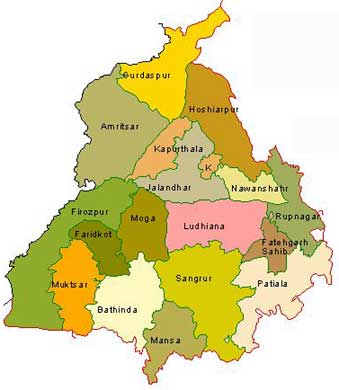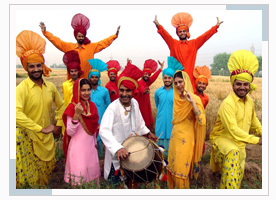Punjab
 The word Punjab is derived from the two Persian words “Panj” which means “five” and “ab” means “water”, so the combined meaning of the Punjab is the land of five rivers namely - Indus, Ravi, Sutlej, Beas, and Jhelum that flow towards the southeast crossing the entire state.
The word Punjab is derived from the two Persian words “Panj” which means “five” and “ab” means “water”, so the combined meaning of the Punjab is the land of five rivers namely - Indus, Ravi, Sutlej, Beas, and Jhelum that flow towards the southeast crossing the entire state.
civilization where early settlement of the Aryan race took place on the fertile soil around 1500 BCE. Punjab is a land of exciting Indo-Aryans culture where Hindus, Jains, Buddhists, ancient Macedonians, Persians, Arabs, Turks, Mughals, Afghans, Balochis, Sikhs and British ruled and intermix with the local people. It was in 1947, Punjab was partitioned between India and Pakistan. Punjab shares its borders with Jammu and Kashmir on its north, Himachal Pardesh on its northeast and Pakistan on its west, Rajasthan on its southwest and Haryana on its southeast.
Tourist Attractions of Punjab
Punjab attracted the tourists from all over the world for various types of tourism like historical tourism, cultural tourism, spiritual tourism, religious tourism, natural tourism etc. The famous tourist attractions of Punjab are Kurukshetra which is famous for the battle ground fought between the Pandavas and the Kauravas; Golden Temple which is the world's most renowned Sikh pilgrimage centre; Anandpur Sahib is famous for religious holiday with important Gurudwaras; Jallianwallah Bagh is famous for historical tourism where innocent people sacrificed their life during freedom struggle; Sheesh Mahal is famous for terraces, gardens, fountains and an artificial lake; Wagha Border offers enchanted spectacle at the time of change of guard; Capitol Complex is famous for the Secretariat, the Assembly, and the High Court; The Open Hand is built of metal sheets; the Rock Garden, Sukhna Lake, Rose Garden are evergreen tourist attractions with their wooded land, false dam on a seasonal stream and nearly 1600 varieties of roses respectively.
 The cultural tourism of Punjab is reflected during the various occasions like harvest festival, New Year celebration, wedding etc. in the form of folk-dance - Krishna Lila or Ras, Nauratra, Nautanki, Naqal, Puppetry, Kheora – folk entertainment, Giddha – folk dance, Kikli – folk dance performed by teen-age girls in groups of two, Jhumar - folk dance of the harvest season and Karthi - mixed dance of men and women.
The cultural tourism of Punjab is reflected during the various occasions like harvest festival, New Year celebration, wedding etc. in the form of folk-dance - Krishna Lila or Ras, Nauratra, Nautanki, Naqal, Puppetry, Kheora – folk entertainment, Giddha – folk dance, Kikli – folk dance performed by teen-age girls in groups of two, Jhumar - folk dance of the harvest season and Karthi - mixed dance of men and women.Fairs and Festivals of Punjab
The culture of Punjab is so rich that every fortnight there is a celebration of fairs and festivals in one part of the state or the other. Some of the famous fairs and festivals of Punjab are Lohri which is celebrated on the occasion of the chilly winter with folk dances around a bonfire; Muktsar fair is celebrated in commemoration of Guru Gobind Singh; Rural Sports is a national fair held in February; Hola Mohalla festival is observed for martial art; Basant Panchami is celebrated on the occasion of the advent of spring; Baisakhi is celebrated on the occasion of a bountiful harvest; The Rauza Sharif 'Urs' is celebrated in the memory of great Sufi Saint Sheikh Ahmad Farooqui Sirhindi and Chhapar Fair which is celebrated to commemorate the descent of the Gugga Pir famous for curing people of snake bites.
- Pathankot
- Ferozepur
- Ludhiana
- Bathinda
- Barnala
- Ahmedgarh
- Amritsar
- Badhni Kalan
- Gardhiwala
- Makhu
- Moonak
- Khem Karan
- Nehon
- Doraha
- Dharamkot
- Ghanaur
- Guru Har Sahai
- Malerkotla
- Anandpur Sahib
- Gurdaspur
- Patiala
- Beas
- Bassi Pathana
- Jalandara
- Faridkot
- Fatehgarh Churian
- Garhshanker
- Malout
- Muktsar
- Kot Fatta
- Budha Theh
- Dasuya
- Dhilwan
- Gidderbaha
- Jalandhar Tour
- Batala
- Fazilka
- Kapurthala
- Taxila
- Bariwala
- Firozpur
- Tarn Taran
- Sangrur





